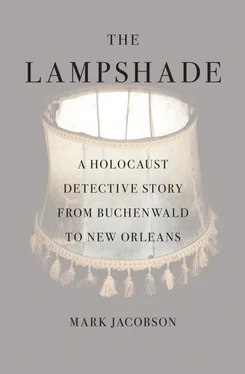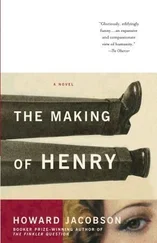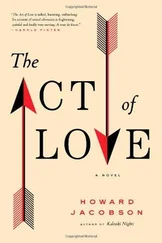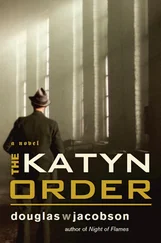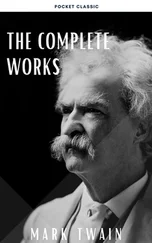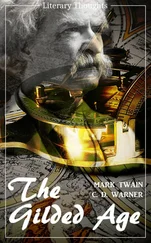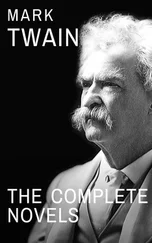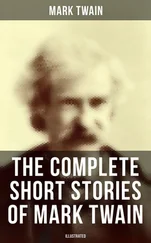“The cemetery robbers came by here offering these stolen statues,” Antippas said in his fast-paced way as he sat in his living room surrounded by large Yoruban sculptures. “It wasn’t Dominici but some of the other guys working with him. They had this marble angel, a really nice piece, and were very, very apologetic because they must have broken one of the wings off when they threw it in the van. They still had the wing, which they set down very carefully beside the angel. They were going on and on about they’d lower the price on account of the damage. It wasn’t even worth it to try and explain that an angel with a broken wing was far more exciting than a regular angel. So I just told them I wasn’t interested. I just didn’t want to get mixed up with that.
“What got me in trouble was when the cops came over. They were looking at every dealer in town. They come banging on the door and right off they see the African stuff. They’re asking me where I got it. The statues were freaking them out. Then they go into the next room, where I had this piece I was working on, The Helmet. I got the idea from a story about a Knight Templar who had gone off to Jerusalem to fight in the Second Crusade. The knight was a great fighter. The pope had personally bedecked his helmet with relics of the saints. But the knight ran afoul of the Muslim defenders and had his head chopped off by Saladin himself. It occurred to me that if a lot of the collections of Western museums are essentially trophy art taken from conquered peoples, then what might it be like if the tables were turned and the Muslims decided to exhibit this dead Knight Templar’s head, with his relic helmet still on, in the main museum of Baghdad or Constantinople. It gave me the idea for the piece.
“I wanted to make it realistic, so I called up some of these people I know who deal with the aftermath of autopsies. This one guy from Cincinnati sent a bunch of eyes with the retinas removed. I incorporated them into the piece. But now the cops are there and they’re going nuts.
“‘These are eyeballs!’ they’re yelling. ‘You got human eyeballs! It is illegal to have eyeballs.’ They thought they’d found, like, the castle of Dr. Frankenstein or something. I’m screaming back at them, ‘They only used to be eyeballs! Now they’re trash. Organic trash! Organic trash from Cincinnati! With the retinas removed.’
“‘The retinas removed?’ one of the cops screams. ‘Who removed them? You?’
“It got out of control from there. I had cut up these lamb skin Forex condoms to simulate skin. Now they’re fixated on that, saying I skinned people to make the piece. I told them, ‘These are condoms, man, condoms!’ They’re not listening to a thing I’m saying. They’re fixated on the condoms. ‘What’s this?’ they’re shouting.
“‘That’s symbolic of the Virgin,’ I said, which was the truth because what is the central idea of Christianity anyway? Belief in the Virgin birth was the reason these Crusaders are in Jerusalem to begin with.
“‘ What ?’ the cops are screaming. And all of a sudden I’m handcuffed to the wall in my own house. The cops are ripping the place apart, going, ‘Look at this, look at this.’ It was like everything I owned was conspiring against me.”
It eventually got worked out, Antippas said, slouching in his chair as if exhausted by the memory of the events.
I asked Antippas if he knew of any African tribe brought to America during the slave trade that might have used human skin in their rituals. Antippas said the only group that came to mind were the Ekoi, a warlike culture from Nigeria known for painting large, flowery murals and making giant masks, often from human skin. Antippas had none of the original masks but did have some pictures, which were simultaneously hauntingly beautiful and creepy.
Around that time I became aware of the Afro-Louisiana History and Genealogy project, a database created by Rutgers University professor Gwendolyn Midlo Hall on captives who may have passed through New Orleans slave auction houses from 1719 to 1820. Most of the information came from the logs of the French slavers, who were easily the match of the Nazis when it came to record keeping. On a whim I entered “Orleans” into the search engine as “Plantation Location” and “Ekoi” for group of African origin.
Only two names came up. One was Felix.
The Felix in question was listed in the database as a black female who first disembarked from the slave ships at age twenty-two in 1792. Her master (recorded as deceased) was named Landry, owner of the plantation Chapitoulas. Her “selling value” was set down as $430. At the bottom of the sheet was noted “woman is pregnant.”
Was this really the record of the Ekoi ancestor of Cheeky Felix, who Dr. John said hung around the Saturn Bar and knew about making things out of human skin? If it was, who would that make the pregnant woman? Cheeky Felix’s ten-times-great-great-grandmother?
I called Dr. John to tell him the news. He was touring somewhere in Colorado, bitching about the altitude. “Cheeky Felix from 1792, that’s far out.” Then he said, if I wanted to keep looking I should talk to Cyril Neville. “Cyril knows things.”
Coincidentally the Neville Brothers, one of New Orleans’s greatest family acts, were due to play at Brooklyn’s Prospect Park band shell, a block and a half from my house, a couple of days later, so talking to Cyril Neville seemed the thing to do. Dr. John said he’d give Neville a heads-up.
“Look,” the Doctor said. “I’m helping you because there’s no time in the world that anyone should be made into a lampshade. I don’t care who it is. No one. You need to get to the bottom of it. So go do it.”
Cyril Neville, then fifty-eight years old and the youngest of the four Neville brothers, didn’t exactly know why Dr. John insisted I talk to him. He said he didn’t know what was happening in New Orleans. He’d left the city after the storm, moved to Austin, Texas, and had no plans to return.
“What for?” Cyril demanded to know. “There’s nothing there. All that tradition and history, and the truth is a musician can’t make a living there. Now you can’t even live there, period. Maybe some fish can, not me.”
Cyril’s brother, the nonpareil Aaron Neville, a large, faintly scary-looking tattooed man with maybe the sweetest voice in the world, sat on the other side of the room eating a sandwich. “We’re scattered to the four winds,” he said.
I gave Cyril the short version of the lampshade story and he was interested but again insisted he had little to add. “Well,” he finally allowed, “there was the Gown Man. If our mother wanted to keep us home, she’d tell us about the Gown Man. He was this big white guy in a hospital gown, and he’d snatch you off the street, put you under his arm, and take you over to the dissection room at Tulane University medical school. They’d pull off your skin and you’d get chopped up by medical students, practicing their autopsies.”
“They had the Needle Man, too. Supposed to shove a six-inch needle in your eye, suck out your brain out right from the socket,” Aaron Neville chimed in.
Showtime was approaching and Cyril looked about ready to say good-bye when he said, “There is this one thing. Don’t know if it helps you or not, but when we were kids our parents used to send us to this Boy Scout camp by the Lake. We’d play ball and that, but on Wednesdays we went to the movies because that’s the day they set aside for black people to go to the movies.
“They always showed these horror movies, like Attack of the Crab Monsters. Creature from the Black Lagoon. The usual shit, trying to scare us, but the movies were so corny, we’d just laugh. Then there was this one time the movie came on and you could tell from the first second this wasn’t going to be the same old thing. The film was all messed-up-looking, with these scratches in it. At first you didn’t see anything. It looked overexposed. Then you saw these people coming out of what looked like a giant hole. These skinny, skinny people, their eyes sunk deep inside their head. They were wearing what looked like striped pajamas. They showed these dead bodies, stacked up. And right away, I was scared. We were all scared. Because we knew this wasn’t something fake. It was real. Remember that, Aaron?”
Читать дальше
